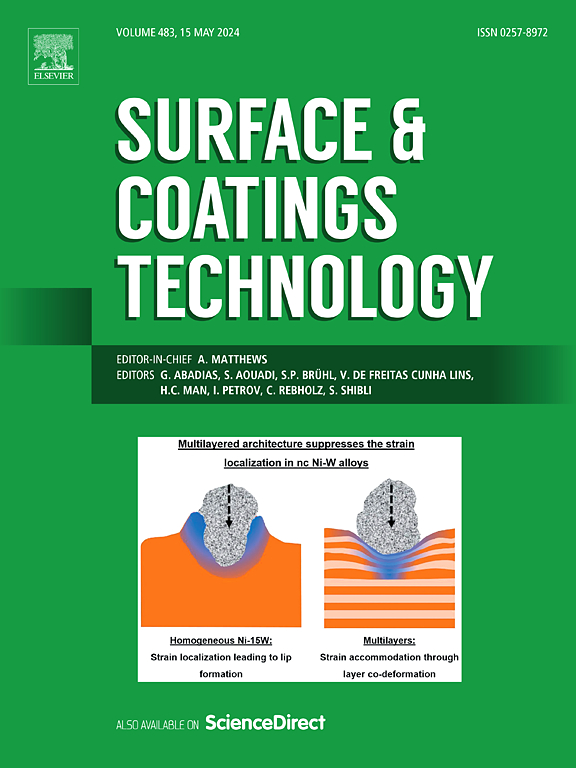基于不同初始粉末粒度的激光熔覆FeCoNiCrCu高熵合金涂层的耐蚀性研究
IF 6.1
2区 材料科学
Q1 MATERIALS SCIENCE, COATINGS & FILMS
引用次数: 0
摘要
研究了不同初始粉末粒径的激光熔覆FeCoNiCrCu高熵合金(HEA)涂层在3.5% NaCl溶液中的腐蚀机理。通过正交实验优化,得到了最佳的激光熔覆参数,得到了质量优异的激光熔覆层。值得注意的是,较细的初始粉末颗粒具有较高的比表面能,有利于形成缺陷较少的涂层。此外,随着初始粉末颗粒的粗化,腐蚀电流密度稳定增加,腐蚀电位下降,同时电荷转移电阻降低。腐蚀优先从表面缺陷开始,更严重的缺陷直接降低耐蚀性。Cu在这些缺陷处的积累形成了一层保护性较弱的钝化膜,阻碍了Cr氧化物的形成。XPS分析表明,与大颗粒形成的保护膜相比,小颗粒形成的保护膜含有更多的Cr氧化物和更少的Cu氧化物。综上所述,由较细的初始粉末粒度制备的涂层具有较好的耐腐蚀性。本文章由计算机程序翻译,如有差异,请以英文原文为准。
An investigation on corrosion resistance of laser-cladded FeCoNiCrCu high-entropy alloy coatings based on different initial powder particle sizes
This study comprehensively investigates the corrosion mechanism of laser-cladded FeCoNiCrCu high-entropy alloy (HEA) coatings fabricated with varying initial powder particle sizes in a 3.5 % NaCl solution. Subsequent to orthogonal experimental optimization, optimal laser cladding parameters were obtained to generate fine coatings with exceptional quality. It's noteworthy that finer initial powder particles possess higher specific surface energy, promoting the formation of coatings with fewer defects. Aside from that, steady increases in corrosion current density and decreases in corrosion potential were observed with coarser initial powder particles, accompanied by lower charge transfer resistance. Corrosion preferentially initiates at surface defects, with more severe defects directly degrading corrosion resistance. The Cu accumulation at these defects generates a less extensively protective passivation film, which hinders the formation of Cr oxides. As evidently demonstrated by XPS analysis, smaller powder particles form protective films with more Cr oxides and fewer Cu oxides in comparison with those formed by larger particles. To sum up, coatings prepared from finer initial powder particle sizes display superior corrosion resistance.
求助全文
通过发布文献求助,成功后即可免费获取论文全文。
去求助
来源期刊

Surface & Coatings Technology
工程技术-材料科学:膜
CiteScore
10.00
自引率
11.10%
发文量
921
审稿时长
19 days
期刊介绍:
Surface and Coatings Technology is an international archival journal publishing scientific papers on significant developments in surface and interface engineering to modify and improve the surface properties of materials for protection in demanding contact conditions or aggressive environments, or for enhanced functional performance. Contributions range from original scientific articles concerned with fundamental and applied aspects of research or direct applications of metallic, inorganic, organic and composite coatings, to invited reviews of current technology in specific areas. Papers submitted to this journal are expected to be in line with the following aspects in processes, and properties/performance:
A. Processes: Physical and chemical vapour deposition techniques, thermal and plasma spraying, surface modification by directed energy techniques such as ion, electron and laser beams, thermo-chemical treatment, wet chemical and electrochemical processes such as plating, sol-gel coating, anodization, plasma electrolytic oxidation, etc., but excluding painting.
B. Properties/performance: friction performance, wear resistance (e.g., abrasion, erosion, fretting, etc), corrosion and oxidation resistance, thermal protection, diffusion resistance, hydrophilicity/hydrophobicity, and properties relevant to smart materials behaviour and enhanced multifunctional performance for environmental, energy and medical applications, but excluding device aspects.
 求助内容:
求助内容: 应助结果提醒方式:
应助结果提醒方式:


